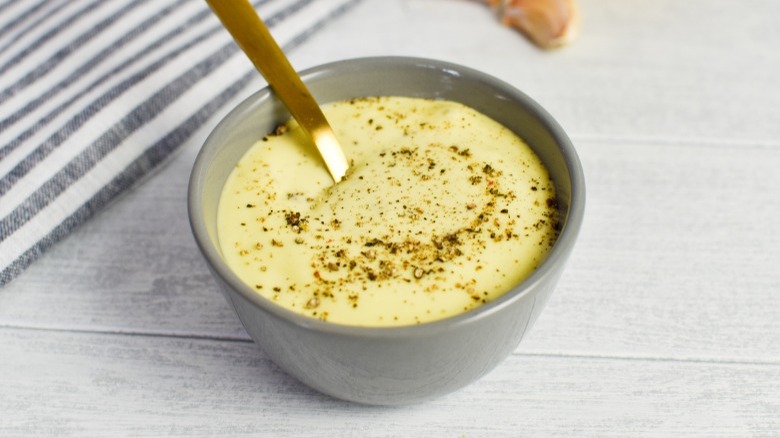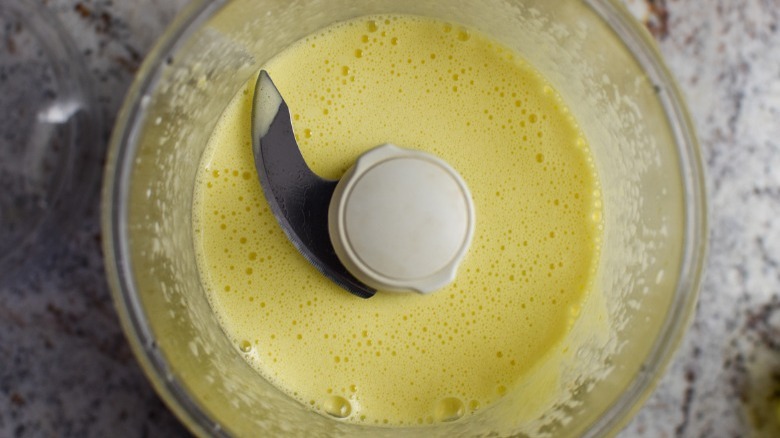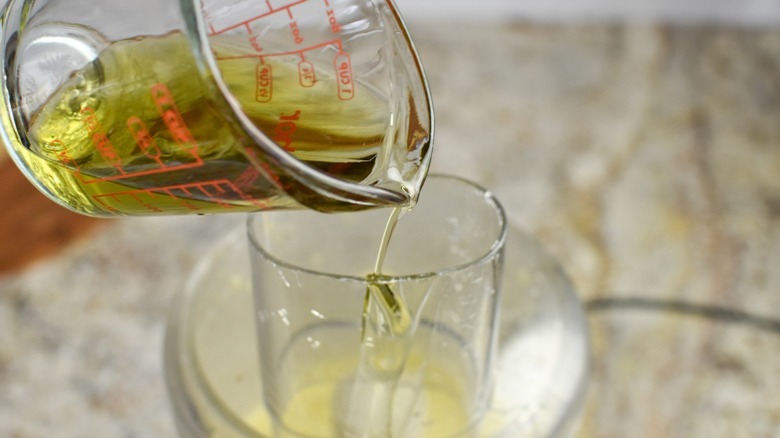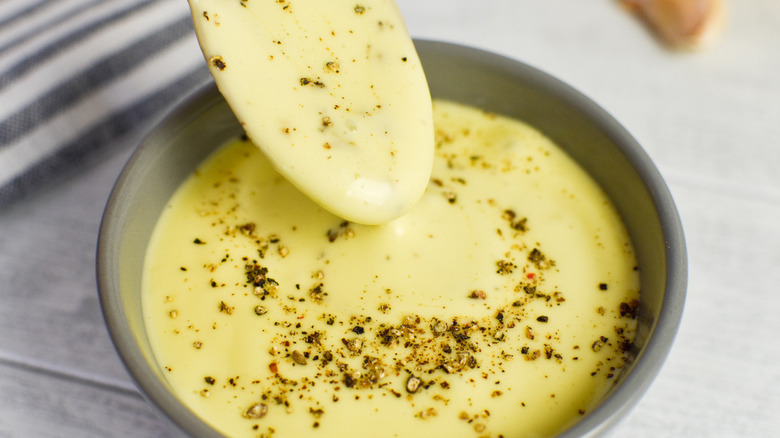Homemade Garlic Aioli Recipe
We may receive a commission on purchases made from links.
Nearly everyone is familiar with mayonnaise; it's a fundamental part of so many foods, from tuna salad to your average deli sandwich. Some people hate mayo, while others say they'd never live (or at least make a grilled cheese) without it. Then, there's aioli, which is basically like mayo's high-class, punchier cousin. Mayo involves a neutral oil, while aioli is made specifically with olive oil and garlic – the term "aioli" even means "garlic oil" in Italian.
Whether you're an aioli fan who hates Hellmann's or love any type of creamy condiment, you may not have tried to make your own aioli at home. But, if you have a food processor or blender, recipe developer Stephanie Rapone's garlic aioli recipe makes it easy to do. Making aioli is a relatively simple process but can have seriously memorable results. "With so few ingredients, I think each one matters, so don't skimp or skip any," Rapone says. "Go for a good olive oil, spend the money to get grapeseed oil, and use fresh garlic, lemon, and pepper." Here's how to make this homemade garlic aioli.
Prep your aioli ingredients
You don't have to do any real cooking to make this aioli, but there are a couple of preparatory steps. For this recipe, all you need is a large garlic clove, a lemon, salt, eggs, grapeseed oil, extra-virgin olive oil, and pepper for garnish.
Start by putting the two uncracked eggs in a bowl of water to bring them to room temperate. Then, get to grating the garlic using a microplane or garlic press. You can also mince it with a knife — just make sure you turn the garlic into a paste.
After that, juice half a lemon, putting 1 teaspoon in a small bowl and the rest of the juice in another. When the eggs are no longer fridge-chilled, crack one whole egg into a small bowl along with just the yolk of the second egg.
Are you in the mood to shake things up? "I've done chipotle instead of garlic and lemon, which is delicious too," Rapone says. That's not her only suggestion: "If you're feeling fancy and can find it, my real favorite is to use black garlic instead of regular garlic," she says.
Fire up the food processor and add your aioli ingredients
It's time to defer to your food processor (or blender, depending on what you have). "I prefer the food processor, but a blender would work great, too, as long as you can stream the oil in while it's running," Rapone says. Start by putting the ingredients you just prepped in (garlic, a small amount of lemon juice, eggs, and salt) and pulse until frothy. Add the olive and grapeseed oils into a measuring cup meant for liquids, which will make the process of adding it to the aioli easier.
Emulsify the aioli with olive oil
With the processor running, slowly drip tiny amounts of oil in. When you notice that the mixture is looking uniform and there's no obvious spots of oil visible, increase the rate at which you're pouring until you've added all the oil. Give it a taste, and if the flavor and texture feels right, you're good to go. If not, add some more salt or lemon juice, as needed. Then, let your newly born aioli sit for about an hour, which will make it more flavorful.
Thorough emulsification is key here, which is why you need the help of an electrical appliance. "I think it would be pretty difficult to get the sauce to emulsify by hand if you don't have a food processor or blender," Rapone says. "I would recommend just doing a 'shortcut' version, instead. In a 'shortcut,' you could use ¾ cup mayonnaise instead of the eggs and oil. Then, just whisk in the garlic paste and lemon and top with fresh cracked black pepper."
Enjoy your homemade garlicky aioli
Your homemade aioli is ready! Top it with a generous dusting of freshly cracked pepper and use it however you desire. "Hands down, my favorite way to eat it is with fries. It's just the perfect fry sauce," Rapone notes. You can spread it on sandwiches or serve it with crudités and fried dippers — the possibilities are endless. If you wind up with extra, that just means more aioli for future you. Keep it in an airtight container in the fridge, and Rapone suggests enjoying any leftovers within three days.
What you can dip into garlicky aioli
Homemade Garlic Aioli Recipe
Whether you hate or love mayo, there's no denying that you'll enjoy this homemade garlic aioli.

Ingredients
- 1 large garlic clove (or more to taste)
- 1 lemon
- ¼ teaspoon kosher salt
- 2 large eggs
- ½ cup grapeseed oil
- ¼ cup extra-virgin olive oil
Optional Ingredients
- freshly ground black pepper, for garnish
Directions
- Place the eggs in a bowl and cover with warm water to bring to room temperature.
- Paste the garlic using a microplane or very fine grater. You can also use a garlic press, or finely mince the garlic then smash it with the side of your knife until it turns to a paste.
- Juice ½ of the lemon. Measure 1 teaspoon of fresh juice and set aside.
- Separate the yolk from one egg and discard the white.
- Add the egg yolk, the white and yolk of another egg, 1 teaspoon lemon juice, the garlic paste, and salt to a food processor or blender.
- Pulse the food processor until the ingredients are evenly blended and frothy.
- Add the grapeseed oil and olive oil to a measuring cup. Turn the food processor on and add the oil very slowly (drop by drop, not a stream).
- Once the mixture starts to thicken and you can see it emulsifying (it's a consistent mixture and you can't see the oil), then start pouring faster, in a thin stream.
- Once all the oil is added, stop the food processor. Check the mixture — the consistency should be similar to mayonnaise. Taste and add more salt or lemon juice, if desired.
- Let the aioli sit for at least 1 hour before serving to allow the flavors to meld.
- Transfer the aioli to a serving dish and top with fresh cracked black pepper.
Nutrition
| Calories per Serving | 201 |
| Total Fat | 21.6 g |
| Saturated Fat | 2.6 g |
| Trans Fat | 0.0 g |
| Cholesterol | 46.5 mg |
| Total Carbohydrates | 1.0 g |
| Dietary Fiber | 0.2 g |
| Total Sugars | 0.2 g |
| Sodium | 76.9 mg |
| Protein | 1.7 g |
How can you customize this aioli?
One clove might seem like a pittance to some garlic lovers, and you can grate in more cloves to your taste. Be careful, though, as the raw grated garlic we use here has a more biting flavor than a cooked preparation. If you want that caramel-y sweetness, roast some garlic cloves in the oven before stirring them into your aioli.
If you want to introduce more flavors, an easy option would be to add some finely chopped fresh herbs to the mix. Since the garlic aioli has a relatively basic flavor, any of your favorite herbs would work here — parsley, cilantro, basil, or dill. Garlic tastes great alongside other aromatic alliums, so you could blend in some scallion greens (for a bit of freshness) or caramelized onions (to amplify the richness).
If you want to add some spice to your aioli, take inspiration from the North Indian condiment burani raita and stir in some ground roasted cumin and red chile powder (or cayenne). You can head a little east and use this aioli as the foundation for an elevated take on sriracha mayo, perhaps replacing the lemon juice with lime. Or, flip the globe and stir in some chipotles in adobo to make the perfect taco condiment.





